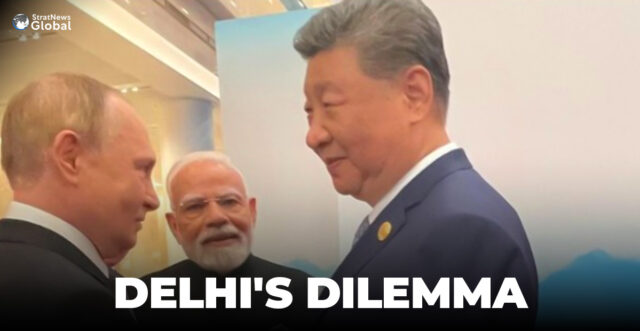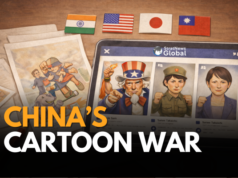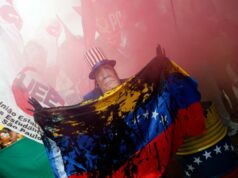India is being forced to navigate the space between the unpredictability of Donald Trump’s America and the relentless rise of China, and Ambassador Nirupama Rao, former Foreign Secretary and envoy to both Washington and Beijing, does not pretend that the task is anything but fraught.
Speaking to Sinologist Manoj Kewalramani on The Great Power Show podcast titled ‘The Revolt of the Orchestra‘, she offered a candid assessment of both relationships, stripped of illusions and softened rhetoric.
Her memories of China capture the scale of transformation. On her first visit in 1986, Beijing was a “kingdom of bicycles” where Soviet-made aircraft rattled through the skies and Maoist slogans still decorated hotel lobbies.
Two decades later, when she arrived as ambassador, the capital was preparing for the 2008 Olympics, the pollution briefly tamed, the self-image transformed. That year’s global financial crisis gave Chinese officials fresh confidence, with what she described as “a new sense of authority, a new sense of confidence, perhaps a sense of having arrived.”
India, by contrast, was left confronting a widening asymmetry. At the same time, Beijing’s embrace of Pakistan never loosened. Rao recalled Premier Li Peng telling India’s defence minister in 1992 that “we don’t abandon our friends” and that Pakistan had stood by China when it was isolated.
She described the impression this left: China insisting it would continue to arm and support Islamabad, while tossing India a token assurance of wanting good relations too. By the late 2000s, the imbalance in economic and strategic weight had only grown, with Beijing pressing its advantage. As she put it starkly, “China sees it as payback time.”
If China radiates certainty, the United States radiates volatility. Rao described the India-U.S. relationship as being at “a very odd and very uncomfortable inflection point”, a place where “strategic convergence as well as political friction are coexisting.” For two decades, defence ties, the Quad, technology partnerships, and a shared concern about China had given the partnership ballast.
That changed under Trump’s second term. Rao did not mince words: the day-to-day political mood now feels “very, very sour, unusually sour”, as if the relationship “has been hit by a hurricane”.
Trump’s decision to slap tariffs on India, including an extra 25 per cent levy tied to Russian oil imports, amounted in her description to India being “thrown under the bus”. The rhetoric has been particularly bruising. She recalled Trump calling India a “tariff king”, adding that “he’s heaped insults on us, really.”
The difficulty, she explained, lies not just in the president’s style but in the political currents shaping him. She pointed to the pull of the MAGA movement, which has hardened American populist nationalism on trade and immigration. In her words, “We matter less to the United States than China in the Trumpian definition of the universe. We’re not an indispensable nation.” For India, that recognition is unavoidable.
Rao was equally clear-eyed about the role of public opinion. In a democracy, she said, “We cannot afford to ignore” domestic outcry, whether it is anger at China after Galwan or resentment over American tariffs.
Diplomats, however, are not supposed to echo rage but to frame it. “Diplomacy is ….not only life without maps, but it should also be life without illusions,” she said. Their job is to convey popular anger “in as civilised a manner as you can”, while also “encouraging a very rational way of thinking about the problems we face”.
Her criticism extended to India’s own blind spots. She noted the growth of China studies in recent decades, contrasting it with the thin scholarship on the United States. India, she observed, has tended to assume it understands America because of English and media access, but “there is so much more to understanding the United States.”
She cited her own exposure to American literature and music long before she ever visited the country, from Faulkner and Hemingway to Dylan and Joan Baez, as shaping her understanding of American history, culture, and contradictions. Without such depth, she implied, Indian assessments risk being shallow, particularly at a time when U.S. domestic politics directly drive policy on trade, immigration, and technology.
She also stressed that illusions cut both ways. If India must understand the United States more seriously, Americans too lack comprehension of India. She recalled Harold Isaacs’ Scratches on Our Minds, which described the superficial stereotypes through which Americans often saw India, in contrast to their deeper engagement with China.
Decades later, she noted, this gap still persists, especially in “flyover country”, where there is little academic engagement with India. For her, this mismatch in perceptions and imagination remains a structural obstacle in bilateral ties.
On China, she was unsentimental. The brief period of trust-building in the late 1980s and 1990s, which she helped shape through the peace and tranquillity agreements, has collapsed. The Tibetan question repeatedly soured her time as ambassador, with midnight summons to the foreign ministry after protests in India.
Today, she said flatly, “that trust is completely eroded.” Economic decoupling is “not going to be possible in the near term,” but disengagement on the border and efforts at de-escalation are “extremely important.”
Essentially, she argues, China is a neighbour that has raced ahead and shows little inclination to accommodate India. The United States is a partner of consequence but also of sharp mood swings, where insults are hurled as easily as handshakes. At home, emotion cannot be ignored, but diplomacy cannot be allowed to drown in it either.
In a career spanning three decades and counting, Ramananda (Ram to his friends) has been the foreign editor of The Telegraph, Outlook Magazine and the New Indian Express. He helped set up rediff.com’s editorial operations in San Jose and New York, helmed sify.com, and was the founder editor of India.com.
His work has featured in national and international publications like the Al Jazeera Centre for Studies, Global Times and Ashahi Shimbun. But his one constant over all these years, he says, has been the attempt to understand rising India’s place in the world.
He can rustle up a mean salad, his oil-less pepper chicken is to die for, and all it takes is some beer and rhythm and blues to rock his soul.
Talk to him about foreign and strategic affairs, media, South Asia, China, and of course India.





